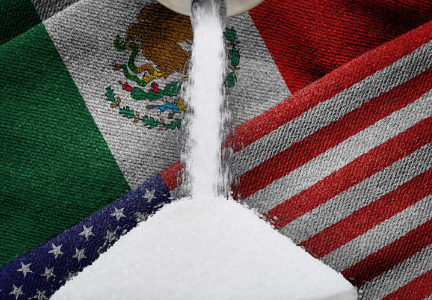LA QUINTA, CALIF. — Mixed views about Mexico’s ability to meet its export commitment to the United States were voiced by speakers Feb. 24 at the International Sweetener Colloquium in La Quinta.
Frank Jenkins, president of JSG Commodities, said he thought Mexico’s forecast of 2019-20 sugar production of 5,672,000 tonnes, actual weight, was a “fairly optimistic outlook.” He showed graphics illustrating Mexico’s sugar production below a year ago through the twentieth week of harvest with sugar cane yields and sugar yield per tonne both below year-ago levels on a weekly basis since about the tenth week of harvest.
“JSG estimates the fiscal year 2020 Mexican crop at 5,250,000 to 5,500,000 tonnes,” Mr. Jenkins said.
As a result, he expects Mexico will not be able to meet U.S. export needs, as defined under the U.S.-Mexico agreements suspending antidumping and countervailing duties on sugar from Mexico.
But Humberto Jasso, executive president of the Mexican Sugar Chamber, which represents sugar mills in Mexico, contended that Mexico still was in a position to meet its export commitment to the United States.
“Mexico can supply the entire U.S. quota assigned last December,” Mr. Jasso said. “Mexico’s sugar surplus is greater than the U.S. quota in force today.
“The Mexican government and the sugar mills are committed to give the U.S. government a responsible and timely response before the end of March, as established under the suspension agreements, regarding the extent to which Mexico can supply U.S. needs as calculated in the March WASDE (the U.S. Department of Agriculture’s World Agricultural Supply and Demand Estimates), as well as every month of the cycle thereafter.”
He noted that Mexico could reduce its 2.5-month supply maintained as ending stocks to a 2-month supply, which could free 184,613 tonnes for export to the United States.
“If the Mexican government adjusts target ending inventories, current Mexican ‘exportable surplus’ would be higher than U.S. needs calculated in February,” Mr. Jasso said.
Meanwhile, Canada also was dealing with a sugar shortage after severe weather reduced the 2019 sugar beet crop by 45%, said Sandra Marsden, president of the Canadian Sugar Institute. Canada produces about 1.3 million tonnes of refined sugar annually, about 90% of which comes from imported raw sugar with no import duties. Canada will make up this year’s beet sugar shortfall with imported raws, she said. Canada historically has imported the vast majority of its raw sugar from Brazil, but last year imports from Brazil dropped dramatically and imports from Guatemala, Mexico and El Salvador increased sharply.
Because of the sharp increase in needed U.S. raw sugar imports, U.S. cane refining capacity “will be tested,” Mr. Jenkins said. Rated annual refining capacity was 6.7 million to 6.85 million short tons, and the highest ever utilization was 6.547 million tons in 2008-09, he said. Last year 6.389 million tons of raw sugar were refined. JSG estimates 4.520 million tons of raw sugar will be available for the February-September period, which on an annualized basis equals 6.78 million tons, he said. If imports from Mexico fall short, and the raw sugar tariff-rate quota is increased, it “will be a challenge to process,” he said.
Mr. Jenkins said the “massive drop” in U.S.M.C.A. production “will thrust U.S.D.A. into a critical role of import management,” although the U.S. industry “faces unprecedented challenges beyond those U.S.D.A. can impact.”
“The industry will need to adapt to avoid widespread shortages despite ample overall supply,” Mr. Jenkins said.
He noted logistical and other challenges of moving imported sugar into deficit areas typically served by the Red River Valley and Mountain states that experienced significant beet crop losses last year.
“Refined (sugar) prices will inevitably rise in coming months,” Mr. Jenkins said, and current pricing for 2020-21 “appears attractive.”





